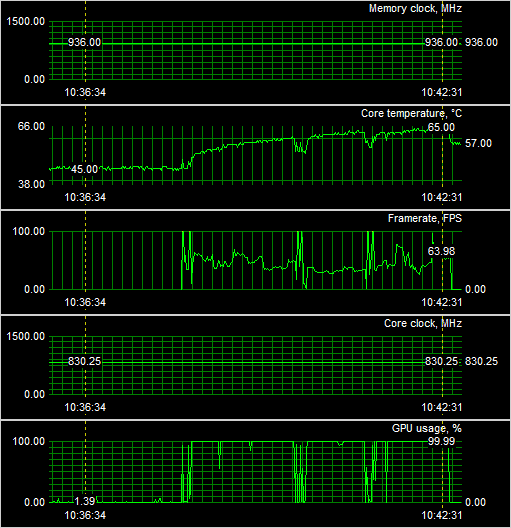Page 5
Power Consumption
Looking at the product from a performance versus wattage point of view, power consumption on the 2600 products is really not bad. Our test system is a Core 2 Duo X6800 Extreme Processor, the nForce 680i SLI mainboard, a passive water-cooling solution on the CPU, 2GB memory, HD DVD-ROM and WD Raptor drive.
The power consumption peaked towards a 222 Watt maximum.
The methodology is simple: we look at the peak wattage during a 3DMark05 session with hefty IQ settings to verify power consumption. It's a good load test as both GPU and CPU are utilized really hard here. Please do understand that you are not looking at the power consumption of the graphics card, but the consumption of the entire PC.
We simply place a wattage meter in-between the PSU and power socket. It's not the most objective way to test as you have to consider PSU efficiency as well, but it's the best thing we can do, though.
In my view:
- Get a 350 to 450 Watt power supply unit with 25 AMPs on the 12-volts rails; it should be really sufficient.
If you have dough to spend and opt the guru path of righteousness by doubling up towards two cards in your system -> Crossfire, then you should end up with a 450 Watt or better PSU with a 30 AMPs 12 Volts rails.
There are many good PSU's out there, please have a look at our many PSU reviews as we have loads of recommended PSU's for you to check out in there. What would happen if your PSU can't cope with the load?:
- bad 3D performance
- crashing games
- spontaneous reset or imminent shutdown of the PC
- freezes during gameplay
- PSU overload can cause it to break down
How hot does this card get ?
As with any graphics card we test, we also take a look at heat build-up in the GPU. Let's have a look. We measured at a room temperature of 22 Degrees C. For the measurement we run a couple of 3DMark timedemo's which will utilize the GPU core 100%; we then simply start to monitor the heat build-up in the graphics core.
The results are not bad. HiS has it's own customized cooler on the 2600 XT though, and it works really well as the card is idling at roughly 45 degrees C and it's maximum peak shows 65 degrees C.
Also as you can see we've been working on a new monitoring feature; the new 2400 and 2600 products will allow us to monitor GPU usage a feature that the new 65nm ATI products allow to be monitored. You are used to this with your CPU, so now we can monitor GPU usage. The benefit here is that internal clocks are adjusted based on this value at hardware level on the 2600 and 2400. Why is this important ? Power consumption. Lowering the clock dynamically also lowers overall power consumption.
Get the new update of Rivatuner supporting this new feature.
Noise Levels coming from the graphics card
When graphics cards produce a lot of heat, that heat usually needs to be transported away from the hot core as fast as possible. Often you'll see massive active fan solutions that can indeed get rid of the heat, yet all the fans these days make the PC a noisy son of a gun. I'm doing a little try-out today with noise monitoring, so basically the test we do is extremely subjective. We bought a certified dBA meter and will start measuring how many dBA originate from the PC. Why is this subjective, you ask? Well, there is always noise in the background, from the streets, from the HD, PSU fan etc etc, so this is by a mile or two not a precise measurement. You could only achieve objective measurement in a sound test chamber.
The human hearing system has different sensitivities at different frequencies. This means that the perception of noise is not at all equal at every frequency. Noise with significant measured levels (in dB) at high or low frequencies will not be as annoying as it would be when its energy is concentrated in the middle frequencies. In other words, the measured noise levels in dB will not reflect the actual human perception of the loudness of the noise. That's why we measure the dBa level. A specific circuit is added to the sound level meter to correct its reading in regard to this concept. This reading is the noise level in dBA. The letter A is added to indicate the correction that was made in the measurement. Frequencies below 1kHz and above 6kHz are attenuated, where as frequencies between 1kHz and 6kHz are amplified by the A weighting.
TYPICAL SOUND LEVELS
Jet takeoff (200 feet)
120 dBA
Construction Site
110 dBA
Intolerable
Shout (5 feet)
100 dBA
Heavy truck (50 feet)
90 dBA
Very noisy
Urban street
80 dBA
Automobile interior
70 dBA
Noisy
Normal conversation (3 feet)
60 dBA
Office, classroom
50 dBA
Moderate
Living room
40 dBA
Bedroom at night
30 dBA
Quiet
Broadcast studio
20 dBA
Rustling leaves
10 dBA
Barely audible
We start up a benchmark and leave it running for a while. The fan rotational speed remains constant. We take the dBA meter, move away 75 CM and then aim the device at the active fan on the graphics cards.
The HiS Radeon HD 2600 XT IceQ Turbo was hardly audible at 38 DBa, and that was noise mostly from the rest of the PC.

